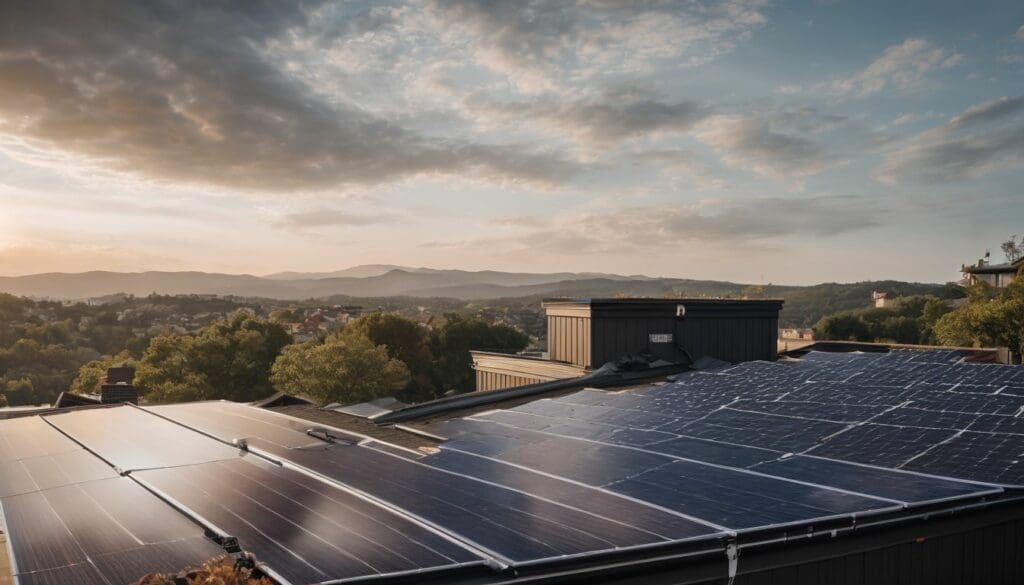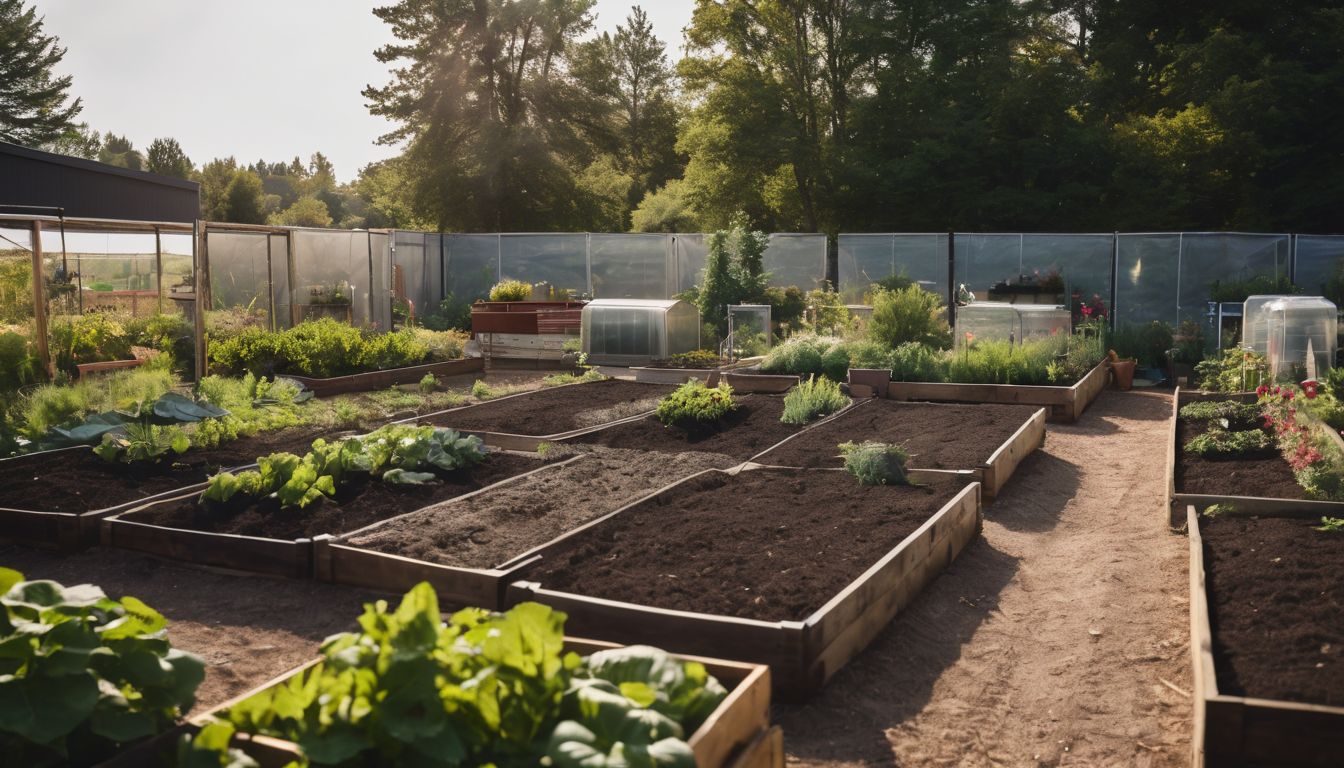Glancing at your energy bill each month can lead to a rather uncomfortable sinking feeling, can’t it? We understand that sense of unease all too well. It’s what prompted us to look heavenwards and consider the sun – not just for its warmth on our faces but as a beacon of hope for our electricity woes.
After delving into the potential of solar panels, we discovered they might reduce those pesky power expenses by up to 70%. With this in mind, we’ve pieced together an uncomplicated guide designed to equip you with the knowledge needed to seize control of your energy future using nothing more than the power provided by your own rooftop.
It’s time to embrace sustainability with open arms!
Key Takeaways
- Before beginning your DIY solar panel project, identify how much energy you need and establish the optimal location for installation on your property.
- Choose a suitable DIY solar kit that meets your specific needs and make sure to obtain all necessary permits from local authorities before starting.
- Install the racking system correctly, connect wiring properly, and securely attach solar panels for efficient energy production; consider installing batteries if going off-grid.
- After installation, schedule an inspection to ensure compliance with safety standards and complete the interconnection process to integrate with the grid.
- Set up a monitoring system and engage in regular maintenance of your solar panels for sustained performance; be ready to troubleshoot common issues as they arise.
Why Consider DIY Solar Panel Installation
Choosing to install your own solar panels can be a wise investment and a rewarding challenge. It allows you to take control of your energy consumption and reduce dependence on fossil fuels.
We embrace sustainable living by harnessing renewable energy, which benefits both our wallets and the environment in the long run. Setting up a solar panel system at home can also grant us independence from unpredictable utility prices and provide consistent electricity, especially in areas prone to outages.
Taking on DIY solar installation empowers us with new skills and knowledge about green technology. Many of us find that assembling a DIY solar kit is less daunting than expected, with comprehensive guides available that simplify each step of the process.
Furthermore, government schemes may offer financial incentives for those installing solar arrays themselves, making it an even more attractive option. Now let’s gear up for what comes next: preparing for your DIY Solar Panel Installation journey!
Preparing for Your DIY Solar Panel Installation
Before starting the DIY installation process, it is crucial to determine your energy needs and assess your property for the best location. Choosing the right DIY solar kit for your home and obtaining necessary permits are also essential steps in preparing for your installation.
Determine Your Energy Needs
To get started with your DIY solar panel installation, it’s vital to understand your energy needs. This will help you determine the size and type of solar panel system that is best suited for your home.
- Analyse your electricity usage over the past year to understand the average amount of energy you consume.
- Consider any future changes in your energy consumption, such as adding new appliances or an electric vehicle.
- Identify peak usage times and aim to size your solar panel system to cover these high-demand periods.
- Factor in any potential savings from implementing energy – efficient practices and appliances.
Assess Your Property and Choose the Best Location
Assessing your property and choosing the best location is crucial for a successful DIY solar panel installation. Here’s how to do it:
- Study your property layout and identify areas with maximum sun exposure throughout the day, typically facing south.
- Avoid shading from nearby buildings, trees, or other obstructions that could reduce solar panel efficiency.
- Consider roof orientation and pitch to determine the most suitable location for solar panel installation.
- Ensure the chosen area can accommodate the number of solar panels required based on your energy needs and available space.
- Check for any local regulations regarding setbacks, easements, or zoning restrictions that may impact solar panel placement.
Choose the Right DIY Solar Kit for Your Home
After assessing your property and choosing the best location for your solar panels, it’s time to select the right DIY solar kit for your home. Consider factors such as the size of your roof, your energy needs, and whether you want to be grid-tied or off-grid.
Look for a kit that includes high-quality solar panels, an efficient inverter, durable racking system, and all necessary wiring components. Ensure that the kit is compatible with any existing electrical systems and meets local regulations.
When selecting your DIY solar kit, take into account any government schemes or incentives available for installation. It’s important to choose a reputable supplier who can provide guidance on which kit best suits your requirements while adhering to legal considerations.
Get Necessary Permits
To install a solar panel system, you’ll need to obtain the necessary permits from your local authorities. These permits typically include building and electrical permits, which are essential for ensuring that your installation meets safety and quality standards.
By obtaining these permits, you can also ensure that your solar panel system is eligible for any government schemes or incentives that may be available in your area. Additionally, having the required permits in place will help with passing inspections and avoiding any legal issues related to your DIY solar panel installation.
Once you’ve chosen the best location for your solar panels and selected the right DIY kit for your home, it’s important to take care of the permitting process before diving into the installation.
Gather Tools and Materials
Before starting your DIY solar panel installation, it’s essential to gather all the necessary tools and materials. Here’s a list of items you’ll need:
- Solar panels
- Racking system components
- Inverter
- Batteries (if you’re going off – grid)
- Mounting hardware and brackets
- Wires, connectors, and conduit
- Charge controller (for off – grid systems)
- Solar panel kit instructions and manuals
- Safety equipment such as gloves, goggles, and a hard hat if required
- Basic hand tools including a drill, screwdriver set, wrenches, wire cutters, and a multimeter
The DIY Solar Panel Installation Process
During the DIY solar panel installation process, you will need to install the racking system, inverter, and solar panels. Additionally, you will need to install batteries and wire the system according to your kit’s instructions.
Installing the Racking System
To install the racking system:
- Measure and mark where the racking system will be installed on your roof, ensuring it is in a location that receives maximum sunlight throughout the day.
- Use appropriate tools to secure the mounting feet to the roof, making sure they are aligned and level to ensure proper support for the solar panels.
- Install the rails onto the mounting feet by securing them properly with bolts and connectors, ensuring stability and straight alignment for the solar panels.
- Attach any necessary grounding components according to local regulations, using appropriate clamps and connectors to establish a secure electrical connection.
- Double – check all connections, ensuring they are tight and secure before proceeding with solar panel installation.
Inverter Installation
To install the inverter, follow these steps:
- Determine the best location for your inverter, ensuring it is close to the main electrical panel and near the solar panels.
- Mount the inverter securely on a wall or other suitable surface using appropriate hardware.
- Connect the DC input from the solar panels to the inverter, ensuring proper polarity and secure connections.
- Connect the AC output from the inverter to your home’s main electrical panel, following all local electrical codes.
- Test the inverter to ensure it is functioning correctly and safely.
Solar Panel Installation
Now that we have covered the inverter installation, it’s time to focus on the solar panel installation process. Here are the steps you need to follow for a successful DIY solar panel installation:
- Installing the Racking System
- Solar Panel Installation
- Installing Batteries
- Wiring the System
Installing Batteries
To power your solar energy system when the sun isn’t shining, we install batteries. Here’s how:
- Select a suitable location for the batteries, ensuring proper ventilation and protection from extreme temperatures.
- Connect the batteries according to the manufacturer’s instructions, following the correct polarity and wiring sequence.
- Secure the batteries in place using appropriate mounting hardware to prevent movement or damage.
- Install a battery monitoring system to keep track of charge levels and overall health.
- Test the battery bank to ensure it is functioning correctly before connecting it to the rest of your solar setup.
Wiring the System
To wire the solar panel system, start by carefully connecting the solar panels to the charge controller using the provided cables and connectors. Next, connect the charge controller to the batteries, ensuring correct polarity and tight connections. Then, connect the inverter to the batteries, following manufacturer’s instructions for safety and efficiency.
Post-Installation Steps
After completing your DIY solar panel installation, it’s important to schedule and pass inspection, complete interconnection, set up monitoring, and keep up with regular maintenance to ensure long-term efficiency and effectiveness of your new energy system.
Scheduling and Passing Inspection
We need to schedule an inspection after completing the installation. This step is crucial to ensure that our DIY solar panel setup meets safety and code requirements. Here are the key steps for scheduling and passing inspection:
- Contact your local building department to schedule an inspection once your solar panel system is installed.
- Ensure that all components, including wiring and mounting brackets, are securely in place and comply with local building codes.
- Prepare a detailed documentation package, including schematics, equipment specifications, and any necessary permits, to present to the inspector.
- Be present during the inspection to address any questions or concerns from the inspector.
- Address any issues raised by the inspector promptly to ensure compliance with regulations and standards.
Completing Interconnection
Completing the interconnection process is vital for ensuring your DIY solar panel system is properly integrated into the grid and ready to start generating clean energy. Here’s a step-by-step guide to completing the interconnection:
- Submit an Interconnection Application to Your Utility Company – Contact your utility company and submit the necessary paperwork to initiate the interconnection process. This may include technical documents, system specifications, and any other required forms.
- Await Approval from Your Utility Company – Once your application is submitted, your utility company will review it to ensure that your solar panel system meets their interconnection requirements. This may involve a technical review of your system design.
- Coordinate with Your Installer for System Inspection – Schedule a time for your utility company to inspect your solar panel system to ensure that it complies with safety and regulatory standards.
- Receive Permission to Operate (PTO) – After passing inspection, you’ll receive permission from your utility company to operate your solar panel system and start feeding excess energy back into the grid.
- Connect Your System to the Grid – With PTO in hand, work with a qualified electrician or installer to physically connect your solar panel system to the grid, ensuring that it operates safely and efficiently.
- Monitor System Performance – Once interconnected, monitor the performance of your solar panel system regularly using monitoring tools provided by your installer or through a third-party service provider.
Setting Up Monitoring
To ensure the optimal performance of your DIY solar panel installation, it is essential to set up monitoring. This allows you to track the energy production and efficiency of your solar panels. Here are the steps to effectively set up monitoring:
- Install a monitoring system that provides real-time data on energy production.
- Use a monitoring platform that offers insights into individual panel performance.
- Connect the monitoring system to your smartphone or computer for easy access to data.
- Set alerts for any irregularities in energy production or system performance.
- Regularly review the monitoring data to identify trends and potential issues.
Maintenance Tips
After setting up monitoring for your DIY solar panel installation, it’s crucial to stay proactive with regular maintenance. This ensures optimal performance and longevity of your system.
Regularly clean the solar panels to remove dirt and debris that can hinder their efficiency. Keep an eye on the wiring and connections for any signs of wear or damage, repairing or replacing as needed to prevent issues down the line.
Monitor the performance of your batteries and inverter, checking for any irregularities that may indicate a problem. Additionally, scheduling periodic professional inspections can help catch any potential issues early on, ensuring your DIY solar panel system continues to provide sustainable energy for years to come without disruptions.
Troubleshooting Common Issues
Encountering common issues during DIY solar panel installation is common. Here are some tips to troubleshoot them effectively:
- Check the connection points for loose wires or corrosion, which can lead to reduced energy production.
- Inspect the solar panels for any damage, such as cracks or hot spots, that could affect their performance.
- Monitor the inverter for error messages or unusual sounds that may indicate a malfunction.
- Ensure that the batteries are charging properly and check for any signs of wear or deterioration.
- Verify the wiring connections and insulate them to prevent exposure to environmental elements.
- Look out for shading issues caused by trees, buildings, or other obstructions that can impact solar panel efficiency.
- Use monitoring systems to track energy production and detect any irregular patterns that may signal an underlying problem.
- Seek professional assistance if you encounter persistent issues beyond your expertise.
Conclusion
In conclusion, planning a DIY solar panel installation can be an empowering process. Installing and maintaining a home solar system is achievable for beginners with the right guidance.
Embracing renewable energy through a DIY approach contributes to sustainable living practices. Making the switch to solar power offers long-term benefits for both individuals and the environment.
It’s time to take charge of your energy consumption and make a positive impact through DIY solar panel installation.
FAQs
1. Can beginners install solar panels at home by themselves?
Yes, with a DIY solar panel installation guide for beginners, anyone can set up their own photovoltaic system to harness green energy.
2. What are the steps involved in installing solar panels myself?
A step-by-step solar panel installation involves planning your solar array, understanding legal considerations, and using a detailed DIY guide to put everything in place.
3. Are there government schemes available for those installing DIY solar panels?
Several government schemes support home solar installations which you can look into to possibly offset some costs or receive incentives.
4. Do I need any special kit for a DIY installation of my own solar panels?
Yes, you will need specific materials which are often included in a comprehensive DIY solar panel kit suitable for offgrid use.
5. Where can I get information on how to properly set up my new energy source?
You can find extensive resources like a beginner’s guide to DIY Solar Energy or diagrams detailing the correct setup process for your new sustainable power system.





